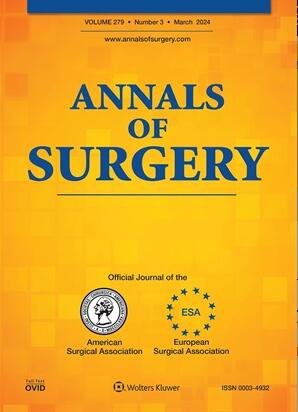Where You Train Matters: Surgeon-Scientists Disproportionately Trained at Highly Funded Institutions.
IF 6.4
1区 医学
Q1 SURGERY
引用次数: 0
Abstract
OBJECTIVE To assess the distribution of National Institutes of Health (NIH)-funded surgeon-scientists by residency training institution and to examine whether training at institutions with higher NIH funding is associated with greater individual NIH funding. SUMMARY BACKGROUND DATA Surgeon-scientists face challenges securing NIH funding, with surgical research funding lagging behind other fields. Training in resource-rich environments may enhance research engagement and funding success. METHODS Blue Ridge Institute for Medical Research (BRIMR) rankings were used to identify NIH-funded principal investigators (NIH-PIs) among surgeons in Departments of Surgery from 2013-2023. Residency program NIH-funding quartiles, and top-ten programs, were determined by averaging institutional funding from BRIMR spreadsheets. Chi-square or Fisher's exact tests, nonparametric tests, Z-tests, and linear regression were performed. RESULTS Among 559 NIH-funded surgeon-scientists, 394 (70.5%) trained at first-quartile institutions, representing 75-82% of NIH-PIs annually and receiving 79-85% of total funding each year. Total annual funding was significantly higher among first-quartile trained NIH-PIs ($117.9 vs. $24.8 million; P <0.0001), though median funding per NIH-PI did not differ ($354,544 vs. $328,179; P =0.358). In subgroup analysis, top-ten trained NIH-PIs had higher median funding per PI ($379,407 vs. $322,666; P =0.013) and experienced faster annual growth in funding per PI ($61,920/year vs. $38,666/year, P =0.009) even when adjusted for current affiliated institution funding quartile. Additionally, top-ten trained PIs exhibited greater scientific influence measured by the NIH iCite tool's weighted relative citation ratio (119 vs. 100; P =0.034). CONCLUSION Surgeon-scientists who trained at first-quartile institutions represent the majority of NIH-funded investigators, highlighting the potential influence of training in well-funded environments.在哪里接受培训很重要:在资金雄厚的机构中接受培训的外科医生不成比例。
目的评估美国国立卫生研究院(NIH)资助的外科医生在住院医师培训机构中的分布情况,并探讨在NIH资助较高的机构接受培训是否与NIH个人资助较高有关。数据外科科学家面临着获得NIH资助的挑战,外科研究资金落后于其他领域。在资源丰富的环境中进行培训可以提高研究参与度和资助成功率。方法采用蓝岭医学研究所(BRIMR)排名,在2013-2023年外科医生中确定nih资助的首席研究员(nih - pi)。住院医师项目美国国立卫生研究院资助的四分位数和前十名的项目是通过平均BRIMR电子表格中的机构资助来确定的。进行卡方检验或费雪精确检验、非参数检验、z检验和线性回归。结果在559名nih资助的外科科学家中,394名(70.5%)在第一四分位数的机构接受培训,占每年nih pi的75-82%,每年接受总资助的79-85%。第一四分位数训练的nih - pi的年度资金总额明显更高(1.179美元对2480万美元;P <0.0001),尽管NIH-PI的中位数资金没有差异(354,544美元对328,179美元;P = 0.358)。在亚组分析中,前10名训练有素的nih PI每个PI的中位数资金更高(379,407美元对322,666美元;P =0.013),即使根据当前附属机构的资金四分位数进行调整,每个PI的资金年增长率也更快(61,920美元/年对38,666美元/年,P =0.009)。此外,通过NIH iCite工具的加权相对引用率(119比100;P = 0.034)。结论:在第一四分之一机构接受培训的外科医生代表了大多数nih资助的研究人员,这突出了在资金充足的环境中接受培训的潜在影响。
本文章由计算机程序翻译,如有差异,请以英文原文为准。
求助全文
约1分钟内获得全文
求助全文
来源期刊

Annals of surgery
医学-外科
CiteScore
14.40
自引率
4.40%
发文量
687
审稿时长
4 months
期刊介绍:
The Annals of Surgery is a renowned surgery journal, recognized globally for its extensive scholarly references. It serves as a valuable resource for the international medical community by disseminating knowledge regarding important developments in surgical science and practice. Surgeons regularly turn to the Annals of Surgery to stay updated on innovative practices and techniques. The journal also offers special editorial features such as "Advances in Surgical Technique," offering timely coverage of ongoing clinical issues. Additionally, the journal publishes monthly review articles that address the latest concerns in surgical practice.
 求助内容:
求助内容: 应助结果提醒方式:
应助结果提醒方式:


